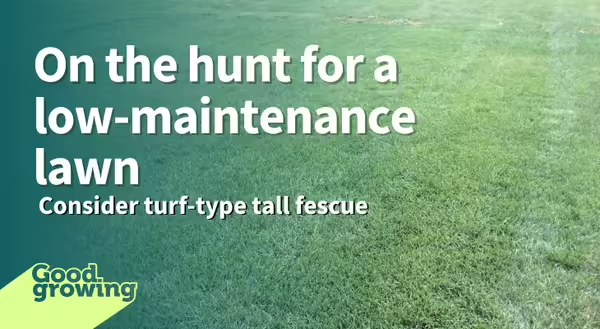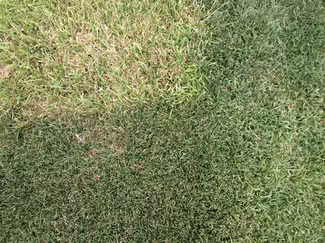
On the hunt for a resilient lawn
Homeowners are seeking lawns that are considered more sustainable than conventional lawns. I often get questions regarding eco-lawns or no-mow lawns, which are great options for certain situations. However, if you have kids, or pets, or intend to use your lawn, it is recommended we stick to a more traditional lawn approach. So, are there any cool-season turf species that will tolerate our use of the lawn and require fewer inputs? Let’s examine tall fescue.
Introducing tall fescue
In the past tall fescue (Schedonorus arundinaceus) has been known as a pasture grass. The mainstay lawn grass species in Illinois has and continues to be Kentucky bluegrass (Poa pratensis), however, that is changing.
The pasture-type tall fescue would be an undesirable lawn grass. The leaf blades are wider, giving a coarser texture compared to Kentucky bluegrass. But tall fescue has some desirable characteristics such as drought tolerance and the ability to grow even in poor soils or low fertility. Because of this resilience, turf breeders have been working to alter the leaf shape of tall fescue to resemble Kentucky bluegrass.
Turf-type tall fescue
Their efforts have been met with success and for the last couple of decades, we have seen a new type of tall fescue on the garden center shelf called turf-type tall fescue (TTTF). When it was first released, TTTF still had a wider leaf than Kentucky bluegrass, therefore, most recommended keeping these two species separate in the lawn because of the contrasting leaf textures (fine vs. coarse).
Today it is common to see lawn seed mixes that contain both Kentucky bluegrass and TTTF. While the two species are still not an identical match, the difference in texture is unlikely to bother most homeowners. For the diehard lawn people and commercial turf companies, they continue to keep these species separate.
What makes TTTF resilient to drought and harsh site conditions is that it develops a larger root system than Kentucky bluegrass. TTTF is also tolerant of partial shade and withstands temporary flooding. Because of these qualities, TTTF is becoming the bread-and-butter of the turf breeding industry.
Cons of turf-type tall fescue
Is it all rainbows and lawn stripes with TTTF? You probably were wondering when the negative points of this lawn species were going to pop up. So here are a few cons of TTTF:
- It is a bunch grower – this means it will not knit together like Kentucky bluegrass after it is damaged and will need to be reseeded.
- The seed is 10 times larger than Kentucky bluegrass – When seed is sold by the pound (and it is!), you won’t get as much coverage and will probably be paying more for TTTF.
- Very low mowing (less than 2 inches) is not conducive to TTTF. A good mow height for TTTF is 4 inches.
- TTTF is very susceptible to a few damaging diseases – brown patch, red thread, and gray leaf spot.
- TTTF is slower to go into dormancy in the summer, meaning it will stay green longer. While that may sound like a good thing, dormancy during summer heat protects the plant and sometimes the TTTF stays green right up to the point where it wilts and dies.
Shopping for turf-type tall fescue varieties
When shopping for TTTF there are many varieties to choose from. However, if you are at the farm store, be sure you avoid purchasing Kentucky 31 for home lawns. Kentucky 31 is pasture-type tall fescue and not Kentucky bluegrass or just a cheap TTTF. (I know, it’s confusing!)
The National Turfgrass Evaluation Program (NTEP) trials the varieties of seventeen turfgrass species in forty U.S. states and six provinces in Canada. Their reports can be found online for each trial year dating back to the 1980s for some species. Following are the top 10 tall fescue cultivar selections from the 2023 NTEP trials (listed alphabetically)
- Clash (AH1)
- Daybreak (AH2)
- Expanse (PPG-TF 262)
- Providence (GO-RH20)
- Serenade (PPG-TF 320)
- Spyder 2 LS (ZRC1)
- Stealth (PPG-TF 238)
- Teacher (PPG-TF 313)
- Titanium G-LS (PPG-TF 255)
- Xanadu (JT 268)
Good Growing Tip of the week: Tempted to swap to a turf-type tall fescue lawn? Late summer to early fall is the best time for seeding a new cool-season lawn in Illinois. Specifically, from August 15 to September 15 in central Illinois.
Sign up for our emails! Want to get notified when new Good Growing posts are available? SIGN ME UP
MEET THE AUTHOR
Chris Enroth is a horticulture educator with University of Illinois Extension, serving Henderson, McDonough, Knox, and Warren counties since 2012. Chris provides horticulture programming with an emphasis on the home gardener, landscape maintenance personnel, and commercial landscapers. Additional responsibilities include coordinating local county Master Gardener and Master Naturalist volunteers - providing their training, continuing education, advanced training, seasonal events, and organizing community outreach programs for horticulture and conservation assistance/education. In his spare time, Chris enjoys the outdoors, lounging in the garden among the flowers (weeds to most).


